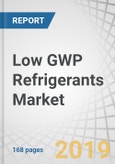The low GWP refrigerants market is projected to grow at a CAGR of 11.7% from 2018 to 2023
Based on type, the hydrocarbon segment is expected to grow at the highest CAGR
Hydrocarbon refrigerants have excellent thermodynamic properties, and refrigerating and air-conditioning systems operating using these substances are highly energy-efficient. Hydrocarbon refrigerants are miscible with conventional refrigerating oils and have a relatively high critical temperature. They are flammable in nature and can be explosive as well; this is a major safety concern associated with the use of hydrocarbon refrigerants and therefore requires hermetically sealed systems with explosion protection for electric components.
Commercial refrigeration segment expected to be the fastest-growing application segment
Commercial refrigeration includes cold displays, refrigerating chambers, ice machines & cold counters, and condensing units commonly used in supermarkets, shops, and centralized units. The commercial refrigeration segment is a rapidly growing sector of the low GWP refrigerants market as it is characterized by a high refrigerant leakage rate and high energy consumption.
South America is expected to be the fastest-growing low GWP refrigerants market
The South American low GWP refrigerants market is driven by development and growth in Brazil and Chile. The countries have been leading the region in terms of economic and infrastructural development and are projected to continue growing despite fluctuations in GDPs. The major end-use industries in the South American low GWP refrigerants market are infrastructure, industrial, oil & gas, and automotive.
Profile break-up of primary participants for the report:
- By Company Type: Tier 1 – 42 %, Tier 2 – 25%, Tier 3 – 33%
- By Designation: C level – 33%, Director level – 22%, Others – 45%
- By Region: North America – 50%, Europe – 17%, Asia Pacific – 25%, Middle East & Africa – 5%, and South America – 3%
Research Coverage:
As part of the qualitative analysis, this research study provides a comprehensive review of major market drivers, restraints, opportunities, and challenges. The report defines, describes, and forecasts the low GWP refrigerants market based on type, application, and region. It provides a strategic analysis of micromarkets with respect to individual growth trends, prospects, and their contribution to the overall market.
It also discusses the competitive strategies adopted by various market players, such as Linde Group (Germany), Honeywell (US), Sinochem Group (China), Airgas Inc. (US), Engas Australasia (Australia), A-Gas (UK), Puyang Zhongwei Fine Chemical (China), Harp International (UK), and Tazzetti (Italy).
Key benefits of buying the report:
From an insight perspective, this research report has focused on various levels of analyses — industry analysis (industry trends), market share analysis of top players, supply chain analysis, and company profiles, which together comprise and discuss the basic views on the competitive landscape, emerging and high-growth segments of the low GWP refrigerants market, high-growth regions, and market drivers, restraints, and opportunities.
The report provides insights on the following pointers:
- Market Penetration: Comprehensive information on low GWP refrigerants offered by top players in the low GWP refrigerants market
- Product Development/Innovation: Detailed insights on upcoming technologies, research & development activities, and new product launches in the low GWP refrigerants market
- Market Development: Comprehensive information about lucrative emerging markets – the report analyzes the markets for low GWP refrigerants across regions
- Market Diversification: Exhaustive information about new products, untapped geographies, recent developments, and investments in the low GWP refrigerants market
- Competitive Assessment: In-depth assessment of market shares, strategies, products, and manufacturing capabilities of the leading players in the low GWP refrigerants market
Table of Contents
Executive Summary
Companies Mentioned
- A-Gas
- A.S. Trust & Holdings
- Airgas Inc.
- Arkema
- Brothers Gas
- Chemours
- Daikin
- Deepfreeze Refrigerants
- Ecofreeze International
- Engas Australasia
- GTS
- Harp International
- Honeywell
- Hychill Australia
- Intergas
- Linde Group
- MK Chemical
- Mexichem
- Puyang Zhongwei Fine Chemical
- SOL Spa
- Shandong Yueon Chemical Industry
- Sinochem Group
- Tazzetti
- The Natural Refrigerants Company
Table Information
| Report Attribute | Details |
|---|---|
| No. of Pages | 168 |
| Published | January 2019 |
| Forecast Period | 2018 - 2023 |
| Estimated Market Value ( USD | $ 16.5 billion |
| Forecasted Market Value ( USD | $ 28.7 billion |
| Compound Annual Growth Rate | 11.7% |
| Regions Covered | Global |
| No. of Companies Mentioned | 24 |









